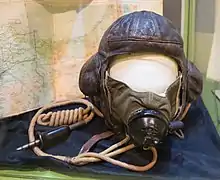

A leather flying helmet, also known as an aviator hat or bomber hat, is a usually leather cap with large earflaps, a chin strap, and often a short bill that is commonly turned up at the front to show the lining (often fleece or fur). It is often worn with goggles. It may be made of other materials, such as felt.[1]
With the rise of motor sport and aviation at the start of the 1900s, leather was becoming a popular choice for protective gear from the cold and the engine noise.[2] It has many advantages that made it the ideal material for flying helmets: It is warm, durable, impermeable to liquids including water, flexible, and can be cut to curve around the head. It is wind proof and has the great advantage of not accumulating dust. It was also found that leather helmets offered some protection against fire.[2] Manufacturers of early flying helmets were Alfred Dunhill Ltd. and Gamages of London, England, and Roold in Paris.[2]
Female pilots in the early part of the 1900s were able to wear the same design of protective clothing, including helmets, as their male counterparts.[2]
British engineers led by Charles Edmond Prince added throat microphones and earphones into these helmets during World War I for hands-free communications in the noisy and windy environment of aircraft cockpits.[3][4]
With the advent of closed-cockpit airplanes, head protection became less necessary (Charles Lindbergh still wore a leather helmet when he crossed the Atlantic in 1927, though his Spirit of St. Louis monoplane had a closed cockpit).
In air forces, leather helmets were continuously used and developed. A well-known early leather flying helmet was the British Type B helmet, designed to accommodate earphones in pockets in the ear-flaps and easy to wear with oxygen masks and goggles.[2] The Imperial War Museum has several examples used in both World Wars, with detailed descriptions.[5][6] See illustration above of a Type B flying helmet that belonged to Spitfire delivery pilot Helen Kerly, now in the Thinktank, Birmingham Science Museum.
With the advent of jet fighters after the Second World War, solid plastic and, later, carbon fiber flight helmets replaced leather helmets in the cockpits of aircraft. Aviator's hats continue in popularity as a fashion accessory and winter headwear.
See also
References
- ↑ Text from the Amelia Earhart Museum
- 1 2 3 4 5 Rood, Graham (2014). "A brief History of Flying Clothing" (PDF). Journal of Aeronautical History. 2014 (1): 3–54. Archived from the original (PDF) on 19 March 2015. Retrieved 7 March 2015.
- ↑ The National Archives, Fighting talk: First World War telecommunications
- ↑ IEEE Spectrum, In World War I, British Biplanes Had Wireless Phones in the Cockpit
- ↑ "Flying Helmet, Leather, Type B: Royal Air Force (1917)". Imperial War Museums. EQU 3845. Retrieved 24 May 2023.
- ↑ "Flying Helmet, B Type: Royal Air Force (1941)". Imperial War Museums. EQU 3932. Retrieved 24 May 2023. Detailed entry describing one of several IWM exhibits.